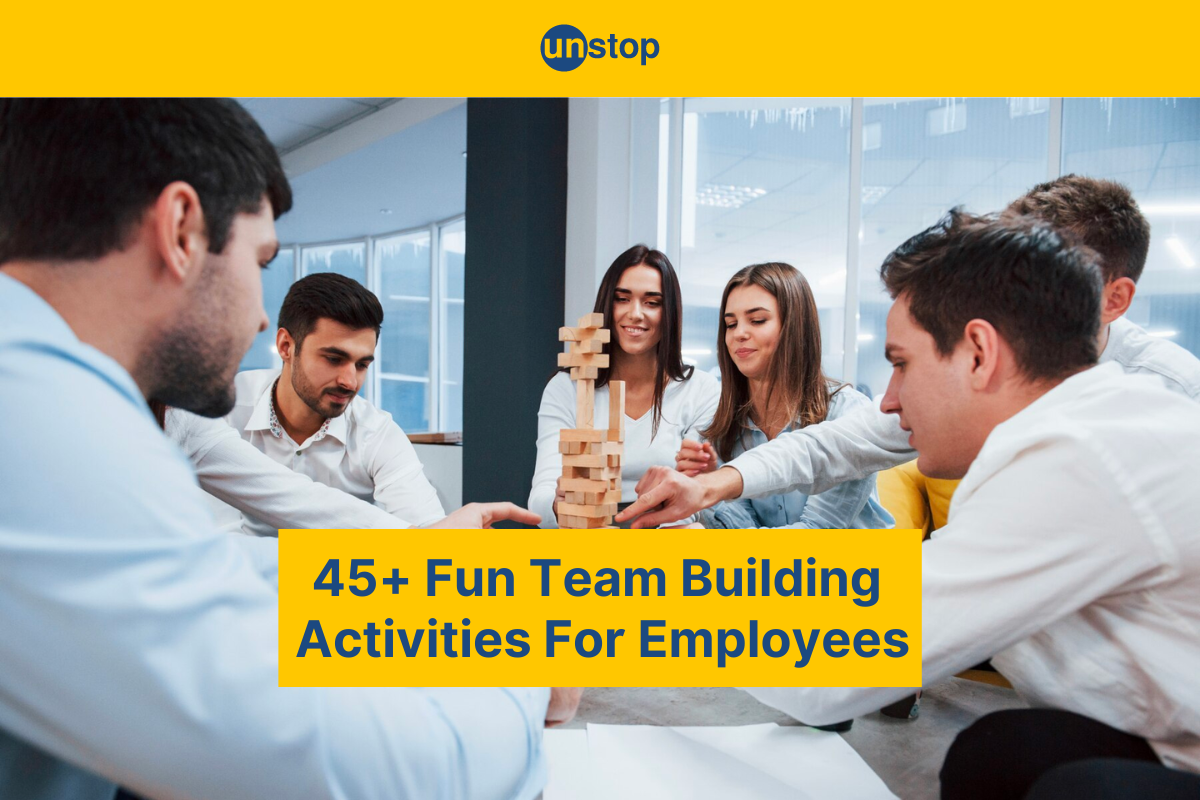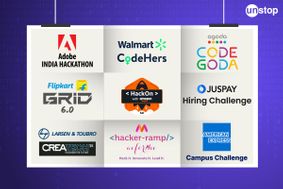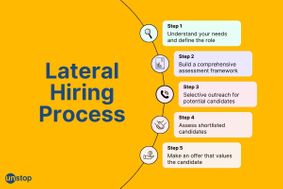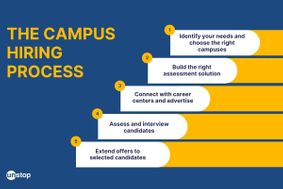- Top Employee Onboarding Software
- Why Use Employee Onboarding Software?
- Key Features of Effective Onboarding Software
- How To Choose The Right Onboarding Software?
- Which is the Best Onboarding Software?
- Frequently Asked Questions (FAQs)
- What Is Upskill And Reskill?
- Difference Between Reskilling And Upskilling
- Upskilling for Workplace Advancement
- Reskilling for Career Transformation
- Crafting Successful Upskill and Reskill Strategies
- Upskill And Reskill Strategizing: Things to Keep in Mind
- Measuring the Impact of Skill Development Initiatives
- Frequently Asked Questions
- What’s a Skill Gap?
- Employee Skill Gap Analysis: Why Do We Need It?
- How To Conduct Employee Skill Gap Analysis?
- Addressing Skill Gaps Through Training and Hiring
- Utilizing Skills Gap Analysis for Strategic Planning
- Leveraging Employee Skill Gap Analysis: Things To Keep In Mind
- Frequently Asked Questions
- Transformative Role of AI in Talent Acquisition
- Impact of AI on Business Recruiting
- Overcoming Challenges in AI-Driven Talent Acquisition
- Starting with AI in Talent Acquisition
- Future Landscape of AI in Talent Acquisition
- Frequently Asked Questions
- HR In The Hot Seat - Challenges With Evolving Workforce
- Mastering Effective HR Management: Tips For Overcoming Challenges
- Summing Up
- The Future of HR: Key Trends for 2024
- Skill-Based Hiring
- Prioritizing Employee Experience, Engagement & Well-being
- AI-Empowered Workforce Evolution and Its Impact
- Taking Diversity, Equity, and Inclusion Beyond Mandates
- Hybrid and Remote Work
- Embracing the Gig Economy and Blended Workforce
- Transparent HR Practices
- Climate Change Adaptation in HR Practices
- Leveraging HR Analytics for Data-Driven Decisions
- Continuous Learning & Development to Improve Productivity
- The Office Buzz in 2024
- Bottom Line - HR Operating Model Needs A Shift
- Importance and Impact of Recognizing Employee Birthdays
- Professional Birthday Wishes for Employees (All Experience Levels)
- Personalized Birthday Wishes for Employees in Different Roles
- Fun Birthday Wishes for Employees (with Templates)
- Birthday Wishes for Remote Employees
- Heartfelt Birthday Wishes for Employees
- Belated Birthday Wishes for Employees
- Simple & Sweet Birthday Wishes for Employees
- Celebrating Employee Birthdays: Ideas and Traditions
- Tips and Ideas for Sending Birthday Wishes to Employees
- Closing Thoughts
- Frequently Asked Questions
- What Is An Employee Referral?
- Benefits of Implementing Employee Referral Programs
- Setting Up an Effective Employee Referral Program
- Employee Referral Email
- Employee Referral Scheme
- Overcoming Challenges of Employee Referrals
- Companies with Best Employee Referral Programs
- Employee Referral Programs: Best Practices
- Closing Thoughts
- Frequently Asked Questions (FAQs)
- Importance of Team Building Activities
- Types of Team Building Activities
- Outdoor Team Building Activities for Employees
- Indoor Team Building Activities for Employees
- Easy Team Building Activities for Remote Employees
- Team Building Activities For New Employees (Icebreakers)
- Fun Team Building Activities for Different Goals
- To Boost Communication and Collaboration
- To Reduce Stress Levels and Promote Well-being
- Aligning Team Purpose and Values with Strategic Activities
- Final Remarks
- Frequently Asked Questions
- Importance of Employee Appreciation Quotes
- Work Appreciation Quotes for Employees
- Employee Appreciation Quotes for Hard Work Recognition
- Employee Appreciation Quotes for Teamwork and Collaboration
- Appreciation Quotes for Celebrating Employee Anniversaries and Milestones
- Employee Appreciation Quotes for Strong Work Ethics
- Employee Appreciation Quotes for Project & Goal Completion
- Employee Appreciation Quotes for Quality of Work
- Employee Appreciation Quotes for Creativity and Innovation
- Appreciation Quotes for Managers
- Peer-to-Peer Employee Appreciation Quotes
- Appreciation Quotes for Employees Leaving the Company
- Employee Appreciation Quotes for Thoughtful Gestures
- Funny Employee Appreciation Quotes
- Short Employee Appreciation Quotes
- Employee Appreciation Quotes for Different Roles
- Employee Appreciation Quotes for Senior Leadership
- Creative Ways to Use Employee Appreciation Quotes
- Summary
- Frequently Asked Questions (FAQs)
- What is Employee Satisfaction?
- Importance of Employee Satisfaction
- Objectives of Employee Satisfaction
- Employee Satisfaction vs. Employee Engagement
- Key Reasons for Employee Dissatisfaction
- Strategies for Improving Employee Satisfaction
- Ways to Measure Employee Satisfaction
- Best Practices for High Employee Satisfaction
- Final Remarks
- Frequently Asked Questions (FAQs)
- How to Craft Effective Employee Appraisal Comments
- Key Areas to Focus in Performance Review
- Comments On Hard Work & Dedication
- Assessing Interpersonal Skills
- Evaluating the Ability to Collaborate & Work in Teams
- Gauging Punctuality
- Commenting on Communication Style
- Reviewing Time Management and Productivity
- Leadership in Performance Appraisals
- Assessing Creativity & Innovation
- Evaluating Problem-Solving Abilities
- Recognizing Flexibility and Dependability in Reviews
- Employee Appraisal Comments for Different Roles
- Summary
- Frequently Asked Questions (FAQs)
- Employee Grievance Meaning
- Importance of Employee Grievance Process
- Types of Workplace Grievances
- Reasons for Employee Grievances
- Employee Grievance Procedure
- Steps in the Employee Grievance Handling Process
- Employee Grievance Form Example
- Final Remarks
- Frequently Asked Questions (FAQs)
- What is Company Culture?
- Importance of Company Culture
- Types of Company Culture
- Factors Contributing to Organizational Culture
- Assessing & Developing Corporate Culture
- Company Culture - It’s not just Perks or Feels
- Good Company Culture Examples
- Developing Company Culture: Best Practices
- Closing Thoughts
- Frequently Asked Questions (FAQs)
- What is Employee Empowerment?
- Benefits of Empowering Employees
- Employee Empowerment vs. Micromanagement
- Strategies for Effective Employee Empowerment
- Role of Managers in Fostering Empowerment
- Organizational Structure Supporting Empowerment
- Overcoming Barriers to Employee Empowerment
- Frequently Asked Questions (FAQs)
- What is Employer Branding?
- Importance of Employer Branding Strategy
- How to Build an Employer Branding Strategy?
- Strategies for Building a Strong Employer Brand
- How to Measure and Boost Your Employer Branding Success?
- Examples of Strong Employer Brand Strategy
- Best Practices for an Effective Employer Branding Strategy
- Closing Thoughts
- Frequently Asked Questions (FAQs)
- What are Employee Wellness Programs?
- Importance of Employee Wellness Programs
- Examples of Employee Wellness Programs
- Real-Life Examples of Corporate Wellness Programs
- Strategies for Encouraging Participation
- Supporting Diverse Employee Needs
- Creating Comprehensive Wellness Programs
- Measuring the Impact on Business and Employees
- Closing Thoughts
- Frequently Asked Questions (FAQs)
- What is Talent Management?
- Developing a Winning Talent Management Strategy
- Models and Frameworks
- Tips for Framing Effective Talent Management Strategy
- Looking Ahead: Recent Trends in Talent Management
- Frequently Asked Questions
- Role of AI in HR: Addressing Common Challenges
- Artificial Intelligence in HR Processes
- AI Tools for HR Functions
- How to Adopt AI in HR?
- Addressing Challenges of AI in HR
- Ethical and Responsible AI Use
- The Future of AI in HR
- Closing Thoughts
- Frequently Asked Questions
- What is Performance Management?
- Elements of Effective Performance Management
- Performance Management Cycle
- Differentiating Performance Management
- Benefits of Performance Management With Examples
- Challenges faced in Performance Management and their Solutions
- Future Trends in Performance Management
- Frequently Asked Questions
- Changing Role of HRM
- Changing Role Of HR Manager
- Technology and the Changing Role of HRM
- The Rise of AI and Machine Learning in HR
- Mobile Technology's Impact on HR Practices
- The Significance of People Analytics in HR
- Navigating the Future of HR Technology
- Final Remarks
- Frequently Asked Questions
- Compensation Management Meaning
- Compensation Types
- Breaking Down The Compensation Management Process
- HR Software for Compensation Management
- Current Trends in Compensation Management
- Frequently Asked Questions
- Defining Flexible Work Arrangements
- Flexible Working: Advantages for Businesses
- Challenges of Flexible Work Arrangements
- Crafting Flexible Working Practices
- Types Of Flexible Work Arrangements
- Comparing Flexible Work Arrangements
- Real-Life Examples of Flexible Work Arrangements
- Final Remarks
- Frequently Asked Questions
- Conflict Resolution Meaning
- Conflict Origins
- Tried & Tested Conflict Resolution Strategies
- Methods of Conflict Management at Workplaces
- Conflict Resolution Strategies: Top Management Tips
- Summary
- Frequently Asked Questions
- Career Development Meaning
- Career Development Plan for Employees
- Career Development in HRM: Growth Ideas For Employees
- Issues in Career Development and Their Solutions
- Closing Thoughts
- Frequently Asked Questions
- Understanding Compensation
- Exploring Benefits
- Difference between Compensation and Benefits
- Compensation & Benefits Structure
- Final Remarks
- Frequently Asked Questions
- Defining Recruitment in HR Practices
- Exploring Talent Acquisition in HR
- Understanding Talent Acquisition vs Recruitment
- When to Recruit or Acquire Talent
- Talent Acquisition vs Recruitment: Responsibilities
- From Recruitment To Talent Acquisition
- Closing Thoughts
- Frequently Asked Questions
- Work Culture Meaning
- Types of Work Cultures
- Components of Culture
- Best Work Culture Examples Set By Top Companies
- Creating a Positive Work Culture
- Closing Thoughts
- Frequently Asked Questions
- Defining Learning vs Development
- Importance of Learning and Development
- L&D Activities for Employees
- Choosing the Right L&D Activities
- Crafting an Effective L&D Strategies
- Aligning L&D Strategy with Business Goals
- Designing Engaging Learning Journeys
- Learning and Development Process: KPIs
- ROI in Learning and Development
- Emerging Trends in L&D
- Closing Thoughts
- Frequently Asked Questions
- What Is Leadership Development?
- Key Skills for Leaders
- How To Develop Leadership Skills in Organizations?
- What Is A Leadership Development Program?
- How To Develop A Leadership Development Program?
- Example of A Leadership Development Plan
- Benefits of Leadership Development Training
- Frequently Asked Questions
- Defining Diversity Training
- Importance of Diversity Training
- What are the Types of Diversity?
- Types of Diversity Training Methods
- Diversity Training Activities
- Choosing A Diversity Training Program
- How to Implement Diversity Initiatives
- Best Diversity Training Programs (Real-Life Examples)
- Improving the Effectiveness of Diversity Training
- Tracking and Evaluating the Results of DE&I Training Efforts
- Essential Elements for Successful Diversity Training
- Closing Thoughts
- Frequently Asked Questions
- Defining Occupational Health & Safety
- Evolution of Workplace Health and Safety
- Identifying Common Workplace Hazards
- Global Impact on Occupational Health & Safety
- Managing Employee Health and Safety Risks
- Occupational Health and Safety Problems
- Future of Occupational Health and Safety
- Frequently Asked Questions
- Employee Orientation Defined
- Employee Onboarding Explained
- Orientation and Onboarding: Understanding the Difference
- Importance of Orientation and Onboarding
- Crafting Comprehensive Integration Strategies
- Quick Tips for Orientation and Onboarding
- Frequently Asked Questions
- What is HR Metrics?
- Importance of HR Metrics
- HR Metrics Examples in Recruitment
- HR Metrics Examples in Employee Retention
- HR Metrics Examples in Revenue
- Other Common HR Metrics
- Soft HR Metrics Example
- HR Metrics Formula
- Utilizing HR Metrics Effectively
- Future of HR Metrics
- Summary
- Frequently Asked Questions
- Defining Decision Making Process
- Key Concepts In Decision Making
- Decision Making & Problem Solving
- Tips For Improving Decision Making Skills
- Selected Practice Questions & Answers
- Conclusion
- Frequently Asked Questions (FAQs)
- A case(s) of miscommunication
- The devil is in the (resume) details
- One for the complaints!
- What is an Exit Interview?
- Benefits of Exit Interviews to an Organization
- How to Conduct Exit Interviews?
- Exit Interview: Sample Questions to Ask
- Overcoming Challenges of Exit Interviews
- Exit Interviews: Best Practices
- Closing Thoughts
- Frequently Asked Questions
- Technology in the Workplace
- Benefits of Tech Integration
- Technology in the Workplace: Key Functions
- How Technology Normalized Remote Work
- Workplace Technology: Top Tools and Software
- Steps for Effective Technology Implementation
- Overcoming Tech Implementation Challenges
- Ethical Considerations in Tech Use
- Keeping Pace with Tech Trends
- Closing Thoughts
- Frequently Asked Questions
- What is Ethical Leadership?
- Principles of Ethical Leadership
- Difference between Ethics and Integrity
- Importance of Ethical Leadership
- Ethical Leadership in Practice
- Overcoming Challenges
- Frequently Asked Questions
- Embracing Change Management
- Mastering People Analytics
- Enhancing Stakeholder Relationships
- Navigating Diversity, Equity & Inclusion
- Upholding Ethics and Data Privacy
- Developing Critical Thinking
- Advancing Negotiation Techniques
- Fostering Inter-departmental Collaboration
- Building Resilience in HR
- Frequently Asked Questions
- What is Mental Health?
- Benefits of a Mentally Healthy Workforce
- Prioritising Mental Health: Creating a Culture of Support
- Final Remarks
- Frequently Asked Questions
- Gen Z vs Millennials - What is the difference?
- Retain and Engage Gen Z Employees: Need and Strategies
- Strategies to Retain and Engage Gen Z Employees
- Rethinking Requirements
- Final Remarks
- Frequently Asked Questions
- Understanding Millennial Leadership Needs
- Key Leadership Skills for Millennials
- How To Develop Millennial Into Leaders
- Additional Strategies to Develop Leaders
- Learning Preferences of Millennials
- Benefits of Investing in Millennial Leaders
- Closing Thoughts
- Frequently Asked Questions
- Understanding Fluff
- Examples of Interview Fluff
- Identifying Interview Fluff
- Addressing Interview Fluff
- Seeing Through the Fluff
- Frequently Asked Questions
- What is the Gender Pay Gap?
- Is the Gender Pay Gap Real?
- Factors Affecting the Gender Pay Gap
- How Age Impacts Women’s Earnings
- The ‘Motherhood Penalty’
- Education's Role in Wage Differences
- Racial and Ethnic Disparities in Pay
- Closing the Gender Gap
- Frequently Asked Questions
- Top Weirdest Late-To-The-Office Excuses
- The Fine Art of Balancing Wit and Wisdom in HR
- Understanding Social Media Recruiting
- Crafting Your Social Media Recruitment Strategy
- Implementing Your Strategy Effectively
- Popular Platforms for Recruitment
- Navigating the Downsides of Social Media Recruiting
- Measuring Success and Adjusting Strategy
- Summary
- Frequently Asked Questions
- Who Is A High Potential (HIPO) Employee?
- Characteristics of A High Potential (HIPO) Employee
- High Potential Employee Identification
- Grooming High Potential Employees
- Why High Potential Employees Leave
- How Do You Retain High Potential Employees?
- High Potential Employee Development: Best Practices
- Closing Thoughts
- Frequently Asked Questions
- What is Digital Fluency?
- Why Digital Fluency Matters?
- Difference between Digital Literacy and Digital Fluency
- Key Components of Digital Fluency
- Achieving Digital Fluency
- Overcoming Challenges
- Future of Workforce Digital Fluency
- Frequently Asked Questions
- What is Loud Quitting?
- Pros and Cons of Loud Quitting
- Reasons Behind the Trend
- Analyzing the Impact
- How HR Can Navigate the Loud Quitting Uproar
- Preventive Strategies
- Closing Thoughts
- Frequently Asked Questions
- Defining Emotional Intelligence in HR
- Why Emotional Intelligence Matters for HR Leaders
- How To Build Emotional Intelligence in HR
- Integrating EQ into HR Practices
- Impact of EQ on Company Culture
- Emotional Intelligence in HR: Major Challenges
- Final Remarks
- Frequently Asked Questions
- Understanding Internal Job Posting
- Internal Job Posting: Pros and Cons
- The Internal Job Posting Process
- Writing Effective Ads for Internal Job Posting
- Strategies for Success of Internal Job Posting
- Summary
- Frequently Asked Questions
- Understanding Workplace Bias
- Common Types of Bias in HR
- Closing Thoughts
- Frequently Asked Questions
- What is a Dry Promotion?
- Dry Promotion: Pros and Cons for Companies
- Impact of Dry Promotion on Employee Retention
- Preventing Talent Loss After Dry Promotions
- Closing Thoughts
- Frequently Asked Questions
- What Is A Stay Interview?
- Importance Of Stay Interviews
- Benefits And Challenges Of Stay Interviews
- Planning And Conducting Stay Interviews
- Stay Interviews: 20 Sample Questions To Ask
- Best Practices For Effective Stay Interviews
- Summary
- Frequently Asked Questions
- Who Is A Boomerang Employee?
- Reasons For Returning
- Benefits Of Hiring Boomerang Employees
- Challenges Of Rehiring
- Interviewing Boomerang Candidates: Sample Questions
- Enhancing The Hiring Process
- Making Informed Decisions
- Final Remarks
- Frequently Asked Questions
- Talent Pipeline Meaning
- Significance of Talent Pipelines
- Advantages of a Talent Pipeline
- Building a Talent Pipeline
- Maintaining a Talent Pipeline
- Attracting Top Talent
- Implementing the Strategy
- Frequently Asked Questions
- What is Micromanagement?
- Recognizing Micromanagement
- Leadership versus Micromanagement
- Keeping Micromanagement in Check
- Beyond Micromanagement
- Summing Up
- Frequently Asked Questions
- Recognizing Signs Of A Bad Hire
- Understanding The Impact On Teams
- Dealing With A Bad Hire
- Preventing Future Bad Hires
- Closing Thoughts
- Frequently Asked Questions
- Defining Neurodiversity
- Importance of Neurodiversity in the Workplace
- Moving Towards Inclusive Environments
- Final Remarks
- Frequently Asked Questions
- Understanding the Generation Gap
- Multigenerational Workforce: Debunking Stereotypes
- Strategies for Bridging the Gap
- Benefits of a Multigenerational Workforce
- Final Remarks
- Frequently Asked Questions
- Defining Productivity Theatre: All Show, No Go
- 5 Key Drivers of Fake Productivity
- Solutions to Combat Productivity Theatre
- Summary
- Frequently Asked Questions
- Defining Grumpy Staying
- Why do Grumpy Stayers not Leave?
- Recognizing the Signs
- Exploring the Causes
- Understanding the Impact
- Addressing the Issue
- Taking Action: Addressing Grumpiness with Empathy
- After the Conversation
- When Grumpy Staying Continues
- Closing Thoughts
- Frequently Asked Questions
- The Rationale Behind Office Peacocking
- Impact on Company Culture
- Impact on Employees
- Case Studies: Examples of Office Peacocking
- The Downside: Potential Pitfalls of Office Peacocking
- Practical Tips for Implementing Office Peacocking
- Frequently Asked Questions
- 13 Common Mistakes Young Managers Make
- Strategies To Avoid Mistakes (Individual Growth)
- How Young Managers Can Boost Teamwork
- Learning From Errors
- Summary
- Frequently Asked Questions
- Understanding Great Regret - What causes the shift shock?
- Impact of Great Regret
- How can HR help make the situation better?
- Closing Thoughts
- Frequently Asked Questions
- Understanding the HR Budget
- Key Components of an HR Budget
- Preparing an HR Budget Step-by-Step
- Importance of HR Budgeting in Management
- Final Remarks
- Frequently Asked Questions
- What are Pre-Employment Assessments?
- Importance of Pre-Employment Testing
- Types of Pre-Employment Assessments
- 15 Tips for Creating Effective Pre-Employment Assessments
- Closing Thoughts
- Frequently Asked Questions
- Exploring the Productivity Paradox
- Understanding the Impact of Solow Paradox
- Productivity Paradox: Why it Matters for Recruiters & HRs
- Identifying Causes and Challenges
- Strategies for Enhancing Productivity
- AI & the Modern-Day Productivity Paradox
- Beyond Technology: Building a Productive Workforce
- Summary
- Frequently Asked Questions
- Understanding the Great Reshuffle 2.0
- Preparing Leaders for the Change
- HR’s Role in Handling Great Reshuffling 2.0
- The Way Ahead
- Frequently Asked Questions
- Definition Of Managerial Grid
- Managerial Grid Theory Explained
- Application Of Managerial Grid
- Criticisms And Limitations
- Evolution And Contemporary Perspectives
- Integrating Managerial Grid With Other Models
- Practical Steps For Implementing Managerial Grid
- Conclusion
- Frequently Asked Questions
- Understanding Skills Taxonomy
- Why do we Need Skills Taxonomy?
- Benefits of Skills Taxonomy
- Components of Skills Taxonomy
- Building a Skills Taxonomy: A Step-by-Step Guide
- Skill Taxonomies vs Intelligence Tools
- Closing Thoughts
- Frequently Asked Questions
- Definition Of Team Building
- Stages Of Team Development
- Top 10 Strategies For Effective Team Building
- Team Building Activities
- Best Practices For Effective Team Building
- Setting Team Building Objectives
- Challenges In Team Building
- Conclusion
- Frequently Asked Questions (FAQs)
- Defining Job Shadowing
- Unpacking the Benefits
- Setting Up the Experience
- Job Shadowing vs Internship
- Dos and Don'ts for HR Professionals
- Closing Thoughts
- Frequently Asked Questions
- Employee Journey Mapping: Meaning & Importance
- Stages of the Employee Journey
- Steps for Effective Mapping
- Employee Journey Map: Where does it begin?
- Employee Journey Map: Template
- Best Practices & Tips
- Summary
- Frequently Asked Questions
- Why are Performance Appraisals needed?
- Evolution of Performance Management
- Modern Performance Practices
- Benefits of Modern Performance Appraisals
- The Future
- Frequently Asked Questions
- Is Experience the Sole Indicator of Success?
- Why Hire Inexperienced Talent?: Key Advantages
- Skills to Look For in Inexperienced Talent
- Challenges and Considerations in Hiring Inexperienced Talent
- Final Remarks
- Frequently Asked Questions
- What is a Company Retreat?
- Company Retreat Ideas: Team-Building & Exploration
- Relaxation and Celebration
- Planning Your Retreat: Things to Keep in Mind
- Closing Thoughts
- Frequently Asked Questions
- Understanding HR Forecasting
- HR Forecasting Key Concepts
- Steps for Implementing HR Forecasting
- Common HR Forecasting Methods
- Closing Thoughts
- Frequently Asked Questions
- What is ESG?
- HR and ESG - Why Care?
- ESG in HR Strategy
- Challenges for HR
- Future of ESG in HR
- Frequently Asked Questions
- Defining the Great Betrayal
- Reasons for Its Spread
- Impact on Workers
- Impact on Corporations
- Rebuilding Trust & Valuing Employees
- Closing Thoughts
- Frequently Asked Questions
- Importance of Clear Expectations
- Setting Expectations Early
- Communicating Expectations Effectively
- Differentiating Expectations
- Reviewing and Adjusting Expectations
- Summing Up
- Frequently Asked Questions
- Understanding KRA Frameworks And Models
- KRAs vs KPAs and KPIs
- Monitoring and Tracking KRAs
- KRAs in Various Roles
- Impact of KRA Frameworks and Models on Organizational Success
- Frequently Asked Questions
- Where: The Place of Work
- When: The Time of Work
- How Much Work: Alternate Employment Models
- Who Does the Work: Intelligence
- Designing Organizations with the Four Dimensions of Work
- Summing Up
- Simplifying Processes: The Foundation of Efficiency
- Reducing Unnecessary Meetings: Reclaiming Valuable Time
- Building Strong Accountabilities: Ensuring Responsibility
- Role of HR in Addressing Inefficiencies
- Continuous Improvement: A Commitment to Excellence
- Leadership's Role in Driving Efficiency
- Conclusion: A Holistic Approach to Efficiency
- Understanding Financial Freedom
- Benefits of Empowering Employees Financially
- Empowering Employees Through Financial Literacy
- Financial Topics That Need Attention Based On Career Stage
- Summing Up
- Frequently Asked Questions
- Defining Employee Voice
- Benefits of Amplifying Employee Voice
- Strategies and Tools
- Encouraging Participation
- Closing Thoughts
- Frequently Asked Questions
- Appraisal Blues: Signs of Unhappy Employees
- Addressing Unhappiness Post-Appraisal
- Non-Monetary Solutions for Dissatisfied Employees
- Summing Up
- Frequently Asked Questions
- Women in the Middle Eastern Workforce
- Importance of DEIB
- Role of HR in Building Inclusive Workplaces for Women
- Measuring Inclusion Progress: Key Metrics
- Closing Thoughts
- Frequently Asked Questions
- Preparing for the Conversation
- Conducting the Conversation
- Best Practices for the Talk
- After the Conversation
- Helping Employees Grow
- Frequently Asked Questions
- Understanding HR Exhaustion
- Factors Leading To HR burnout
- Impact Of HR Burnout
- Strategies To Prevent And Manage HR Burnout
- Role Of Technology In Preventing Burnout
- Celebrating HR Successes
- Summary
- Frequently Asked Questions
- Common Mistakes When Hiring Young Talent
- Building Connections with Candidates
- Summary
- Frequently Asked Questions
- Walking a mile in the employee’s shoes
- Conducting Humane Layoffs
- Remote Layoffs Management
- Supporting Laid-off Workers
- Managing the Aftermath
- Wrapping Up
- Frequently Asked Questions
- Importance of Shortening Time-to-Hire
- Shortening Hiring Time: Pre-Application Stage
- Reducing Hiring Time: Application Stage
- Hacks to Shorten Hiring Time: Interview Stage
- Reducing Hiring Time: Offer Stage
- 5 Other Important Hacks & Strategies
- Final Remarks
- Frequently Asked Questions
Team Building Activities For Employees: 45+ Games That Are Actually Fun

“Talent wins games but teamwork and intelligence win championships.” - Michael Jordan
Former basketball player Michael Jordan’s quote sums up the importance of teamwork. In any field, from sports to corporates, teamwork is integral to success. It’s why organizations often plan engaging and effective team building activities for employees, that can help boost morale, enhance communication, and foster a positive work environment.
From collaborative challenges to creative problem-solving tasks, these activities are designed to strengthen bonds among team members and improve overall productivity. Let’s understand more about why they’re important, the different types of team building activities for employees, and how to pick the best one(s) for your organization.
Importance of Team Building Activities
Fostering Unity and Camaraderie
Team building activities for employees foster unity and camaraderie within a company. Engagement in team building activities also helps to break down barriers between team members, regardless of their positions within the organization. For example, participating in a team-building retreat where they solve challenges together can create lasting msemories.
Through shared experiences like group problem-solving tasks or outdoor adventures, employees learn to appreciate each other's strengths and work better as a cohesive unit.
Improving Morale and Motivation
When employees feel connected to their peers through shared experiences outside of work tasks, they tend to be more satisfied with their jobs. This increased job satisfaction leads to higher productivity levels and lower turnover rates within the organization.
Moreover, team building events often include elements that challenge individuals both mentally and physically. Overcoming these challenges as a team instills a sense of accomplishment and pride among employees, motivating them to tackle work-related obstacles with the same determination.
Enhancing Communication and Collaboration
Team building activities for employees provide opportunities for staff members to practice active listening, effective communication skills, and constructive feedback exchange. As an illustration, engaging in trust-building exercises can help break down communication barriers that may exist among team members.
Furthermore, collaborative tasks during team-building events require participants to work together towards a common goal. This fosters teamwork skills such as delegation, cooperation, and coordination – all vital components of successful workplace collaboration.
Types of Team Building Activities
Outdoor Adventure Activities
Outdoor adventure activities are fantastic for promoting teamwork and enhancing problem-solving skills among employees. Engaging in outdoor adventures can also help employees develop resilience and communication skills while working towards common goals.
These activities often include challenges like rock climbing, obstacle courses, or wilderness survival tasks. They create opportunities for individuals to rely on each other's strengths to overcome obstacles effectively.
Learn from an example: A company might organize a team hiking trip where employees must navigate through rough terrain together to reach a destination. Such experiences foster trust and collaboration among team members.
Indoor Team Building Games
Indoor team building games provide an excellent platform for fostering creativity and encouraging critical thinking within teams. These games can range from puzzles and escape rooms to group problem-solving activities.
Participating in indoor games allows employees to think outside the box, collaborate closely, and practice effective communication strategies in a fun setting. Moreover, indoor games often require teamwork to achieve success, reinforcing the importance of cooperation in achieving shared objectives.
Learn from an example: An office may host a "murder mystery" game night where employees work together to solve a fictional crime scenario.
Virtual Team Building Activities
From virtual hiring to permanent remote workers, a hybrid workplace is the norm in 2024. Thus, virtual team building activities for employees have become increasingly popular due to the rise of remote work environments. These activities leverage technology platforms such as video conferencing tools and online collaboration software to bring distributed teams together virtually. Examples include virtual escape rooms, online trivia contests, or digital scavenger hunts tailored for remote participation.
Virtual team building provides opportunities for social interactions beyond work-related discussions. It helps combat feelings of isolation by creating shared experiences that strengthen connections between team members who may not physically meet regularly.
Find a host of employee engagement activities on Unstop and pick the one that best suits your needs.
Outdoor Team Building Activities for Employees

- Trust Fall: One team member falls backwards, relying on their teammates to catch them. The goal of Trust Fall Game is to build trust and communication within the team.
- Team Size & Time Required: The ideal team size is 4-6 members, and the activity typically takes around 10-15 minutes.
- Obstacle Course: Teams navigate through a series of physical challenges together. The goal is to promote teamwork, problem-solving, and leadership skills.
- Team Size & Time Required: The team can be between 6-8 members, and the activity can last anywhere from 30 minutes to 1 hour.
- Scavenger Hunt: Teams work together to find and collect items on a list within a specified time frame. The goal is to encourage collaboration, communication, and creativity.
- Team Size & Time Required: A team size of 4-5 members is ideal, and the activity usually takes around 1-2 hours.
- Team Relay Races: Teams compete in relay races with various challenges. The goal is to foster teamwork, coordination, and friendly competition.
- Team Size & Time Required: It usually needs 4-6 members per team, and the races can be completed in 20-30 minutes.
- Wilderness Survival: Teams learn basic survival skills in the wilderness. The goal is to promote teamwork, critical thinking, and problem-solving under pressure.
- Team Size & Time Required: The ideal team size is 3-5 members. This activity needs a day-long commitment.
- Outdoor Escape Room: Teams solve puzzles and riddles outdoors to "escape" within a time limit. The goal is to enhance teamwork, communication, and lateral thinking.
- Team Size & Time Required: Usually, a single team requires 4-6 members. A single game typically lasts for 1-2 hours.
- Orienteering: Teams use a map and compass to navigate through a course. The goal is to improve communication, decision-making, and problem-solving skills.
- Team Size & Time Required: A team of 2-4 members is ideal for the activity. The course itself can take 1-2 hours to complete.
- Raft Building: Teams build a raft using limited materials and race it across a body of water. The goal is to enhance teamwork, creativity, and resourcefulness.
- Team Size & Time Required: The team size is 6-8 members, and the activity can take around 1-2 hours to build and race the raft.
- Camping Trip: Teams go on a camping trip together, participating in various outdoor activities. This is a type of work retreat or offsite. The goal is to strengthen relationships, foster camaraderie, and promote work-life balance.
- Team Size & Time Required: The ideal team size can vary but usually ranges from 4-10 members, and the trip can last for a weekend or longer.
- Paintball or Laser Tag: Teams compete against each other in a paintball or laser tag game. The goal is to encourage teamwork, strategy development, and friendly competition.
- Team Size & Time Required: Usually, teams are divided into groups of 4-6 members per team. A single game of paintball or laser tag lasts for 30 minutes to an hour.
Indoor Team Building Activities for Employees

- Office Trivia: Employees participate in a trivia game based on company history, policies, or industry knowledge to boost teamwork and knowledge sharing.
- Team Size & Time Required: The ideal team size is around 4-6 members, and the game usually takes about 30-45 minutes to complete.
- Blind Drawing: One team member describes an image to their teammates who must draw it without seeing the original, emphasizing clear communication and listening skills.
- Team Size & Time Required: This game works best with teams of 3-5 members, and it typically takes 20-30 minutes to finish.
- Marshmallow Tower: Teams compete to build the tallest tower using only spaghetti noodles, tape, and marshmallows, encouraging creativity and collaboration.
- Team Size & Time Required: Teams of 4-8 members are ideal for this activity, and it can take anywhere from 45 minutes to an hour to build the towers.
- Memory Wall: Employees share personal anecdotes or fun facts on sticky notes, then try to match each story to the correct colleague to strengthen team bonds.
- Team Size & Time Required: A team size of 5-7 members is recommended for this game, and it usually takes about 30-40 minutes to complete.
- Lego Building: Teams race against the clock to build a specific structure using Lego pieces, enhancing communication, creativity, and time management skills.
- Team Size & Time Required: Teams of 3-4 members work well for this game, and it typically takes around 45 minutes to finish building the structure.
- Team Pictionary: Employees take turns drawing and guessing various words or phrases as a team, improving collaboration, creativity, and quick thinking.
- Team Size & Time Required: The ideal team size is around 4-6 members, and the game usually takes about 30-45 minutes to complete.
- Indoor Scavenger Hunt: Teams follow clues around the office to find hidden items or complete tasks, fostering teamwork, communication, and problem-solving skills.
- Team Size & Time Required: Teams of 5-8 members are recommended for this activity, and it can take anywhere from 45 minutes to an hour to finish the hunt.
- Board Game Tournaments: Organize friendly competitions with classic or modern board games, promoting laughter, communication, and team spirit.
- Team Size & Time Required: Team size can vary depending on the game chosen, but typically 4-6 members per team work well. The duration of the tournament will depend on the number of games played.
- Improv Comedy Workshop: Learn basic improv techniques to enhance creativity, communication, and spontaneous thinking in a playful setting.
- Team Size & Time Required: This activity can accommodate larger teams of 6-10 members, and workshops usually last for about an hour.
- Role-Playing Scenarios: Discuss assigned topics or simulate real-world situations, practicing persuasive communication and active listening. These can also be a fun way to break barriers.
- Team Size & Time Required: Teams of 3-5 members are ideal for this activity, and the duration can vary depending on the complexity of the scenarios, but typically around 30-45 minutes per scenario.
For example, Unstop organized a “roast your manager’’ session where team members took turns roasting their managers. The event was a success, with team members bonding over shared jokes and idiosyncrasies.
Easy Team Building Activities for Remote Employees

- Virtual coffee breaks: Schedule regular virtual coffee breaks where team members can casually chat and catch up with each other. The end goal is to foster social connections and boost team morale.
- Ideal team size: Any size; Required time: 15-30 minutes
- Online trivia games: Organize virtual trivia games for team members to participate in to encourage friendly competition and teamwork.
- Ideal team size: 4-8 members; Required time: 30-60 minutes
- Virtual happy hours: Host virtual happy hours where team members can unwind and socialize over drinks. This promotes team bonding and relaxation.
- Ideal team size: Any size; Required time: 1-2 hours
- Remote team lunches: Coordinate remote team lunches where team members can eat together virtually. It helps create a sense of togetherness and camaraderie.
- Ideal team size: Any size; Required time: 30-60 minutes
- Online scavenger hunts: Organize online scavenger hunts where team members have to find specific items within their own homes. The end goal is to encourage creativity, teamwork, and fun.
- Ideal team size: 4-6 members; Required time: 45-60 minutes
- Virtual book club: Start a virtual book club where team members can read and discuss books together. This promotes learning and fosters stronger connections between colleagues.
- Ideal team size: 6-10 members; Required time: Ongoing, based on book length
- Remote fitness challenges: To promote health, wellness, and team spirit, initiate remote fitness challenges where team members can participate in physical activities together.
- Ideal team size: Any size; Required time: Varies based on challenge duration
- Virtual Bingo: Create bingo cards with squares containing funny work-related phrases or inside jokes. As someone mentions a phrase, mark it off. The first to complete wins bragging rights.
- Ideal team size: 4-10 members; Required time: 30-60 minutes
- Online team building games: Play online team building games such as Pictionary, charades, or virtual escape rooms. The end goal is to encourage teamwork, communication, and problem-solving.
- Ideal team size: 4-8 members; Required time: 45-60 minutes
- Virtual Show & Tell: Give everyone 30 seconds to share a unique object, photo, or experience from their life. Sparks conversation and fosters interest in diverse backgrounds.
- Ideal team size: Any size; Required time: 30-45 minutes
Quick tip! Remember to consider time zones and schedules when planning activities.
Team Building Activities For New Employees (Icebreakers)
Icebreaker Games: An icebreaker game is a fun and interactive activity designed to help people get to know each other better (break the ice in a group setting) and create a more comfortable and engaging atmosphere. Icebreaker games can be tailored to suit various preferences and team sizes.
These games are often used at the beginning of meetings, workshops, training or mentorship sessions, or social gatherings to encourage communication, build relationships, and set a positive tone for the rest of the event. Icebreaker games can range from simple name games to more elaborate team-building exercises, all aimed at fostering connections and promoting a sense of camaraderie among participants.
Examples of Icebreaker Activities
- Two Truths and a Lie: Team members take turns sharing two truths about themselves along with one lie while others guess which statement is false. The goal of this activity is to help team members get to know each other better.
- Team & Time Requirements: This icebreaker activity works well with teams of any size, but smaller groups of 4-12 members allow for more engagement. It typically takes around 15-30 minutes to complete.
- Storytelling Relay: Start a story prompt, and each team member adds a sentence remotely, creating a collaborative and humorous tale. This activity not only fosters creativity and teamwork but also encourages active listening skills as participants build upon each other's contributions to shape the narrative.
- Team & Time Requirements: This activity works well with larger teams of 6-20 members and can take anywhere from 20-45 minutes to complete.
- Emoji Charades: Each person picks an emoji card and acts out the emotion without speaking while others guess the emotion being portrayed. The purpose of this activity is to engage participants in a fun and interactive way while also practicing non-verbal communication skills.
- Team & Time Requirements: Best suited for smaller teams of 3-8 participants and typically lasts around 10-20 minutes.
- We Have Something In Common: Participants are tasked with finding something they have in common with each other. This can be anything from sharing the same favorite color to having visited the same vacation spot. The goal is to encourage conversation and connections based on shared interests or experiences.
- Team & Time Requirements: This activity works effectively with teams of any size, but smaller groups of 4-12 members allow for more meaningful connections. This activity can take around 15-30 minutes.
- One-Word Icebreaker: In this activity, participants take turns saying a single word that describes how they are feeling or what comes to mind when prompted by a specific topic. This game is meant to be quick and spontaneous, allowing individuals to express themselves succinctly and creatively while also learning more about each other's thoughts and emotions.
- Team & Time Requirements: This game is ideal for groups of 5-15 members, and it usually lasts around 10-15 minutes.
Customizing icebreakers also involves considering the time constraints and objectives of the activity. Some quick icebreakers are ideal for short meetings or workshops where time is limited but connection-building remains crucial.
Fun Team Building Activities for Different Goals
To Stimulate Creative Thinking and Innovation
When teams engage in activities that require them to think outside the box, it fosters innovation and creative thinking. These activities encourage individuals to approach challenges from different perspectives, leading to unique ideas that may not have surfaced in a traditional work setting.
Examples:
- Build a Bridge Contest: Divide teams and provide limited materials to construct the strongest bridge, pushing creativity and resourcefulness. Tasks like building a structure with limited resources or solving complex puzzles can push employees to explore unconventional solutions.
- Time & Team Requirements: This game typically requires around 1-2 hours to complete, depending on the complexity of the bridge design and construction. Teams of 3-5 members are ideal for this activity to encourage collaboration and creativity.
- For the Plot: A moderator will describe the plot of a movie to players who are divided into teams. The teams will then try to guess which movie or television show is being described. This activity aims to stimulate creative thinking and innovation by encouraging participants to think critically and use their knowledge of popular media to solve the challenge.
- Time & Team Requirements: This game can be played in approximately 30-45 minutes, making it a quick and engaging activity for teams. It is best suited for teams of 4-6 members to ensure active participation and diverse perspectives when guessing the movies or TV shows described by the moderator.
To Improve Analytical Skills & Problem-Solving

One of the key benefits of team building activities is the opportunity they provide for employees to enhance their problem-solving skills. The challenges presented during these exercises require participants to analyze situations, identify issues, and develop effective solutions collaboratively.
Examples:
- Puzzles like Jenga: Games like Jenga are fun and educational. As the tower becomes more unstable, players must analyze the situation, anticipate the consequences of their moves, and adapt their strategy accordingly. This constant need for problem-solving helps improve analytical skills and decision-making abilities in a fun and engaging way.
- Time requirement: Each game typically lasts around 10-15 minutes.
- Team requirement: Can be played individually or in teams of 2 or more.
- Guess who: Organizers pick a theme (sports players, entrepreneurs, celebrities, etc.) and select famous personalities. Participants are divided into teams. Each team sends one member to select the celebrity to enact. The rest of the team members take turns guessing the celebrity.
- Time requirement: The game can last anywhere from 30 minutes to an hour, depending on the number of participants.
- Team requirement: Participants are divided into teams, usually consisting of 3 or more members.
To Boost Communication and Collaboration

By engaging in activities that require sharing ideas and opinions, team members learn to express themselves freely.
Examples:
- Word Chain: Start with a word and each person takes turns saying another word that starts with the last letter of the previous word. Promotes quick thinking and vocabulary skills.
- Time & Team Requirements: This game can be played with as little as two people and has no specific time limit. It can be a quick icebreaker activity or a longer game depending on the group's preference.
- Collaborative Art Project: Create a piece of art together, discussing ideas, dividing tasks, and coordinating efforts.
- Time & Team Requirements: The time and team requirements for this activity can vary depending on the complexity of the project. It is recommended to have a small team of at least 3-4 people to ensure effective collaboration.
- The time needed can range from a few hours for a simple project to several days for a more elaborate piece of art. It is important to establish clear communication and roles within the team to complete the project successfully.
To Reduce Stress Levels and Promote Well-being

By engaging in fun group activities, employees can unwind from work pressures, fostering a more relaxed mindset.
Examples:
- Fun games & activities: Organizing a team picnic or sports day can provide a refreshing break from daily routines. Companies can also organize in-house Tambola Night, or plan a cricket match. The idea is to take a collective break from work and indulge in some good, old-fashioned fun and games.
- Time & Team Requirements: Team picnic or sports day can typically last a few hours and require participation from all team members. In-house Tambola Night or a cricket match can be organized during after-work hours or on weekends, with teams consisting of a minimum number of players to ensure an enjoyable experience.
- Compliment Circle: Compliment Circle is a team-building activity where team members sit in a circle and take turns giving compliments to each other. This activity helps boost morale, strengthen relationships, and promote a positive and supportive work environment. Participants are encouraged to express genuine appreciation for their colleagues, which can help reduce stress levels and improve overall well-being. Compliment Circle is a simple yet effective way to foster a sense of camaraderie and unity within a team.
- Time & Team Requirements: This team-building activity can be incorporated into a regular team meeting or as a standalone session lasting around 30 minutes to an hour. It is ideal for small to medium-sized teams where each member can actively participate in giving and receiving compliments.
- Most Likely To...: Ask questions like "Who is most likely to be late for a meeting?" and have everyone vote anonymously. This creates laughter and reveals personalities in a lighthearted way.
- Time & Team Requirements: This game can be played during a break or at the end of a workday, lasting around 15-30 minutes depending on the number of questions asked. It works well with teams of any size, as long as there are enough participants to vote anonymously and create a fun and engaging atmosphere.
Aligning Team Purpose and Values with Strategic Activities
Strategic team building exercises are designed to help employees grasp their significance in achieving company goals. These activities provide insight into how each individual's contributions fit into the broader organizational objectives.
Reinforcing Organizational Culture
By aligning team building activities for employees with company values, organizations can strengthen the core principles that guide their operations. When team members understand the impact of their work on the company's success, they are more motivated and engaged in their roles.
Inspiring Shared Purpose
Mission-focused team building activities inspire a shared sense of purpose among team members by connecting them to the organization's overarching mission or vision. When employees participate in activities that reflect the company's core values and long-term objectives, they develop a deeper understanding of why their work matters.

Examples:
- Volunteer work: Engaging in volunteer projects as a team can demonstrate how collective efforts can make a positive impact on society while strengthening bonds among colleagues.
- Time requirement: Varies based on the project.
- Team requirements: Ideally, the entire team can participate, but smaller groups can also work on different projects simultaneously.
- Job Shadowing: Organize job shadowing experiences within the team. Freshers shadow senior employees and vice versa, fostering empathy for each other's roles and challenges.
- Time requirement: Typically a half or full day per shadowing session.
- Team requirements: Pairing up individuals from different experience levels within the team.
- Start-up Simulations: Divide into teams and simulate launching a new service or product targeting the company’s audience. Promotes teamwork, innovation, and strategic thinking.
- Time requirement: Can range from a few hours to a full day, depending on the depth of the simulation.
- Team requirements: Small teams of 3-5 members to ensure active participation and collaboration.
Final Remarks
Team building activities foster a cohesive and productive work environment. By incorporating a variety of engaging exercises, organizations can enhance communication, collaboration, creativity, problem-solving skills, and overall employee well-being. Whether in-person or virtually, these activities contribute to aligning team values with strategic goals, ultimately leading to a more motivated and connected workforce.
To maximize the benefits of team building efforts, encourage participation across all levels of the organization. Emphasize the importance of these activities in building strong relationships, improving teamwork, and enhancing overall job satisfaction. By prioritizing team building initiatives, companies can create a positive and inclusive workplace culture that drives success and innovation.
Frequently Asked Questions
1. What is the significance of team building activities in a workplace?
Team building activities foster stronger relationships, improve communication, and boost morale among employees. They enhance collaboration, trust, and overall productivity within teams.
2. How can icebreaker games benefit teams in a work environment?
Icebreaker games help break down barriers between team members, encourage interaction, and create a positive atmosphere. They promote teamwork and build camaraderie among colleagues.
3. Why are virtual team building activities essential for remote teams?
Virtual team building activities bridge the gap between remote employees by fostering connections and maintaining engagement. They boost morale, strengthen teamwork, and combat feelings of isolation or disconnection.
4. How do team-building strategies contribute to enhancing creativity and problem-solving skills?
Team-building strategies encourage brainstorming sessions, promote out-of-the-box thinking, and provide opportunities for collaborative problem-solving exercises. This fosters creativity while improving the ability to tackle challenges effectively as a team.
Suggested Reads:
- Quizzes For Assessment Of Candidates for Upskilling, Promotion, & Hiring
- Live Quizzing vs Treasure Hunt: Choosing What Suits Your Requirements
- Birthday Wishes For Employee: 30+ Samples That Make For A Thoughtful Gesture
- Employee Referral 101: Unlock Benefits, Best Practices & Top Schemes
- Employee Skill Gap Analysis: What Is It & How To Conduct It?
I’m a reader first and a writer second, constantly diving into the world of content. If I’m not writing or reading, I like watching movies and dreaming of a life by the beach.
Login to continue reading
And access exclusive content, personalized recommendations, and career-boosting opportunities.
Subscribe
to our newsletter
Blogs you need to hog!

Organize Hackathons: The Ultimate Playbook With Past Case Studies

What is Campus Recruitment? How To Tap The Untapped Talent?

Lateral Hiring: A Complete Guide To The Process, Its Benefits, Challenges & Best Practices













Comments
Add comment